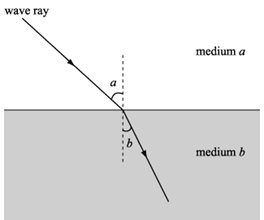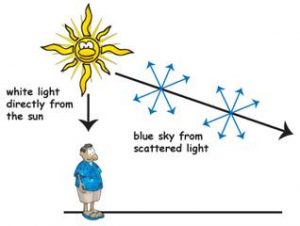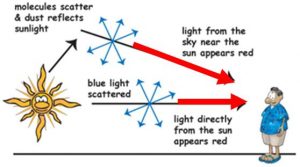Recent Comments
Archives
Categories
- No categories
Meta
3.2. Energy Interactions with the Atmosphere
Objectives
- To understand how electro-magnetic radiation interacts with the Earth’s atmosphere and the consequences of this interaction for remote sensing
- To understand the different types of atmospheric scatter, atmospheric absorption processes, and atmospheric refraction
All radiation used for remote sensing passes through the atmosphere before and after it has interacted with the Earth’s surface. The atmosphere alters the radiation’s frequency, intensity, and direction. In reality, of course, atmospheric effects on remotely sensed imagery are complex and diverse. Radiance measured by an air- or space-borne sensor is affected by numerous factors, not solely diffuse sky irradiance between the sensor and the target on the Earth’s surface. The atmosphere mainly affects the visible and infra-red wavelengths and has more minor effects on the microwave wavelength. There are three physical processes involved:
- scattering, which changes the direction and intensity of radiation (see illustration below).
- absorption, in which incident radiation is retained by constituent parts of the atmosphere, thereby reducing its intensity.
- refraction, which changes the direction of radiation as it passes through the atmosphere (see illustration below).
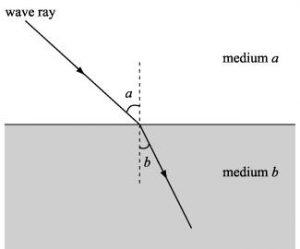
Atmospheric Refraction
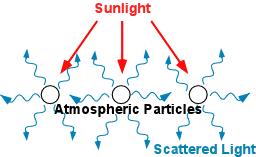
Atmospheric Scattering
Scattering
Scattering is the redirection of electromagnetic radiation by particles suspended in the atmosphere. The amount of scattering which takes place depends on the size of the atmospheric particles, the abundance of these particles, the wavelength of the electromagnetic radiation, and the depth of the atmosphere. There are four main types of scattering:
- Rayleigh scattering
- Mie Scattering
- Non-selective scattering
- Raman scattering
Rayleigh scattering was discovered by Lord Rayleigh in the 1890s, for which he received the Nobel Prize in Physics in 1904. This type of scattering is caused by gases in the upper atmosphere, more specifically by particles that are smaller than the wavelength of the radiation. As shown by the equation below, the degree of scattering (Τ in the equation below) is inversely proportional to the fourth power of wavelength (λ in the equation below).

As shown in the diagram below, what this means is that Rayleigh scattering is much greater for shorter wavelengths compared to longer wavelengths.
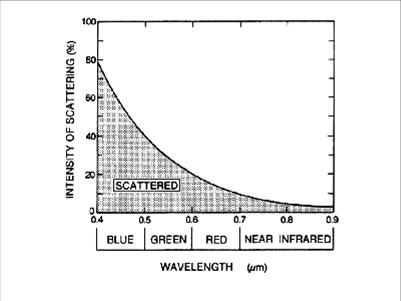
Activity
On a cloud-free day, to an observer on the ground, the sky appears blue.

Given what you know about atmospheric scattering, why is the sky blue (a question often also asked by young children!)?
Show Answer
Activity
On some days with relatively cloud-free skies, at sunrise and sunset, the sky appears red in colour.
Why do we see red skies at sunrise and sunset sometimes (another question popular with young children!)?
Show Answer
Mie scattering was discovered by Gustav Mie in the early 1900s. This type of scattering relates to particles that are equal in size to the wavelength of the radiation. In the context of the visible part of the spectrum especially, this type of scattering is caused by water vapour and dust, both of which are found in the lower atmosphere. Unlike Rayleigh scattering, Mie scattering is much less dependent on wavelength.
Non-selective scattering is caused by particles that are much larger than the incident radiation (e.g. water droplets and large dust particles). It generally takes place in the lower atmosphere. Non-selective scattering is not wavelength dependent: all wavelengths are scattered equally. This type of scattering is the primary cause of haze in remotely sensed imagery. An example of haze in a ground-based photograph of a landscape is shown below.

Activity
When we look up at the sky, clouds typically appear white in colour (or occasionally grey).

Why is it that clouds appear white (yet another question that you may be asked by an inquisitive young child!)?
Show Answer
The final type of scattering, Raman scattering, was discovered by Sir C.V. Raman in 1928. This form of scattering occurs as a photon has an elastic collision with molecules, resulting in a loss or gain in energy. Such scattering can increase or decrease the wavelength of radiation and is associated with atmospheric particles of any size or material.
In summary, atmospheric scattering is a function of the wavelength of the incident radiant energy and the size of the gas molecule, dust particle and / or water vapour droplet encountered in the atmosphere. The atmospheric path length (shorter as radiation reaches the Earth’s surface at noon compared with sunrise and sunset) also affects scatter.
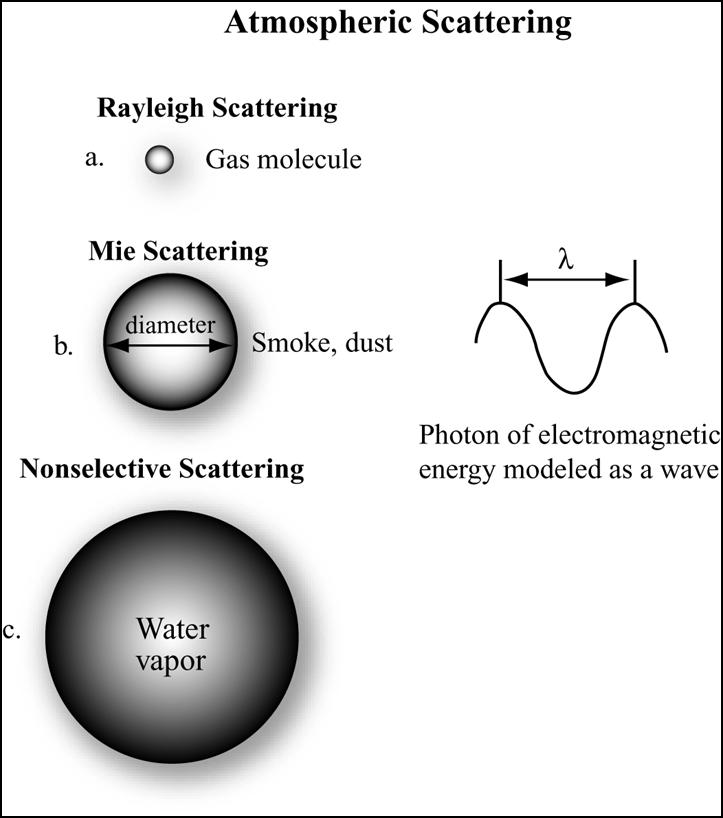
Absorption
Atmospheric absorption is the process by which radiant energy is retained by substances in the atmosphere. The many different gases and particles within the atmosphere absorb radiation at both longer and shorter wavelengths than visible light. Unlike scattering, there is a loss of energy as part of this process. Energy acquired by the atmosphere in this way is radiated at longer wavelengths. There are three main absorbers of radiant energy in the atmosphere:
- Ozone (O3) in the upper atmosphere, which absorbs ultra-violet light
- Carbon dioxide (CO2) in the lower atmosphere, which absorbs mid and far infra-red wavelengths
- Water vapour in the lower atmosphere, which absorbs far infra-red wavelengths
There are some wavelengths of the electromagnetic spectrum where atmospheric absorption is high and others where it is low. Areas of low absorption are sometimes referred to as atmospheric windows and it is these regions of the spectrum that provide the best opportunity for remote sensing. As shown in the figure below, the key atmospheric windows are:
- the visible window (0.4 – 0.9 μm)
- the near infra-red window (1.5 – 1.75 μm, 2 – 2.4 μm)
- the far infra-red window (3 – 5 μm, 8 – 14 μm)

Refraction
Refraction occurs when electro-magnetic radiation passes from one medium to a second medium of different density. This occurs in the atmosphere where it is stratified. In a stable atmosphere, its effects are minimal. In a turbulent atmosphere, refraction influences the direction of incident and outgoing radiation, thereby affecting the geometric accuracy of a remotely sensed image (put simply, it makes it more problematic to associate the radiant energy detected by a sensor with a specific part of the Earth’s surface).
